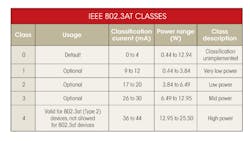Design engineers have a considerable amount of flexibility in selecting power levels within the specifications of both the IEEE 802.3af and 802.3at versions of the PoE standard. IEEE 802.3af specifies four classes, 0 through 3, and IEEE 802.3at adds a fifth class, all relating to different power levels that will be made available. Classification for a particular device is negotiated at the time of the initial connection (see the table).
Related Articles
- POE Targets More Applications With Higher-Power IEEE 802.3bt
- Understanding Power-Over-Ethernet
- Integrated PoE-PD Controllers Meet Upcoming PoE+ Standard
Under IEEE 802.3af, the PSE has the option of performing a classification or not. The PD, however, must provide a valid class if the PSE presents the class voltage. A PD will provide a class 0 signature by presenting a 25k resistor, the same resistor value used for detection. Therefore, a Type 1 PD doesn’t need to do anything special to comply with classification.
Some form of classification is required for the PSE under IEEE 802.3at. To accomplish that, a concept called mutual identification was introduced. Essentially, both the PD and the PSE are aware of the capabilities of the other end.
PSEs have two ways to classify a PD and are free to use either. The first is the hardware-based method where a specific resistance is presented when the PSE presents the classification voltage. The other is software-based and uses the Link Layer Discovery Protocol (LLDP). Since it requires layer 2 access, it is only available for endspans. (By definition, midspans only inject power and do not interact with the data stream.) The PD must support both, which means all PDs must have a 13-W mode after boot so it can perform LLDP negotiation.
Mutual ID begins when the PSE performs LLDP and receives confirmation that the PD is a Type 2. Conversely, the PD now knows it has a Type 2 PSE. Alternatively, the PSE can present a two-finger class waveform that has been defined in the standard. The PD presents Class 4 to each of the class cycles. The PSE knows it is interacting with a Type 2 PD because it has identified two consecutive Class 4 classifications. The PD knows it has a Type 2 PSE because it saw detection and then two fingers of classification.
Chad Jones is the acting chair of the P802.3bt Task Force and a member of the IEEE 802.3 4-pair Power over Ethernet Study Group. A hardware engineer with a large systems vendor, he currently holds six patents, most related to PoE. He can be reached at [email protected].
About the Author
Chad Jones
Acting Chair
Chad Jones is the acting chair of the P802.3bt Task Force and a member of the IEEE 802.3 4-pair Power over Ethernet Study Group. A hardware engineer with a large systems vendor, he currently holds six patents, most related to PoE. He can be reached at [email protected].

